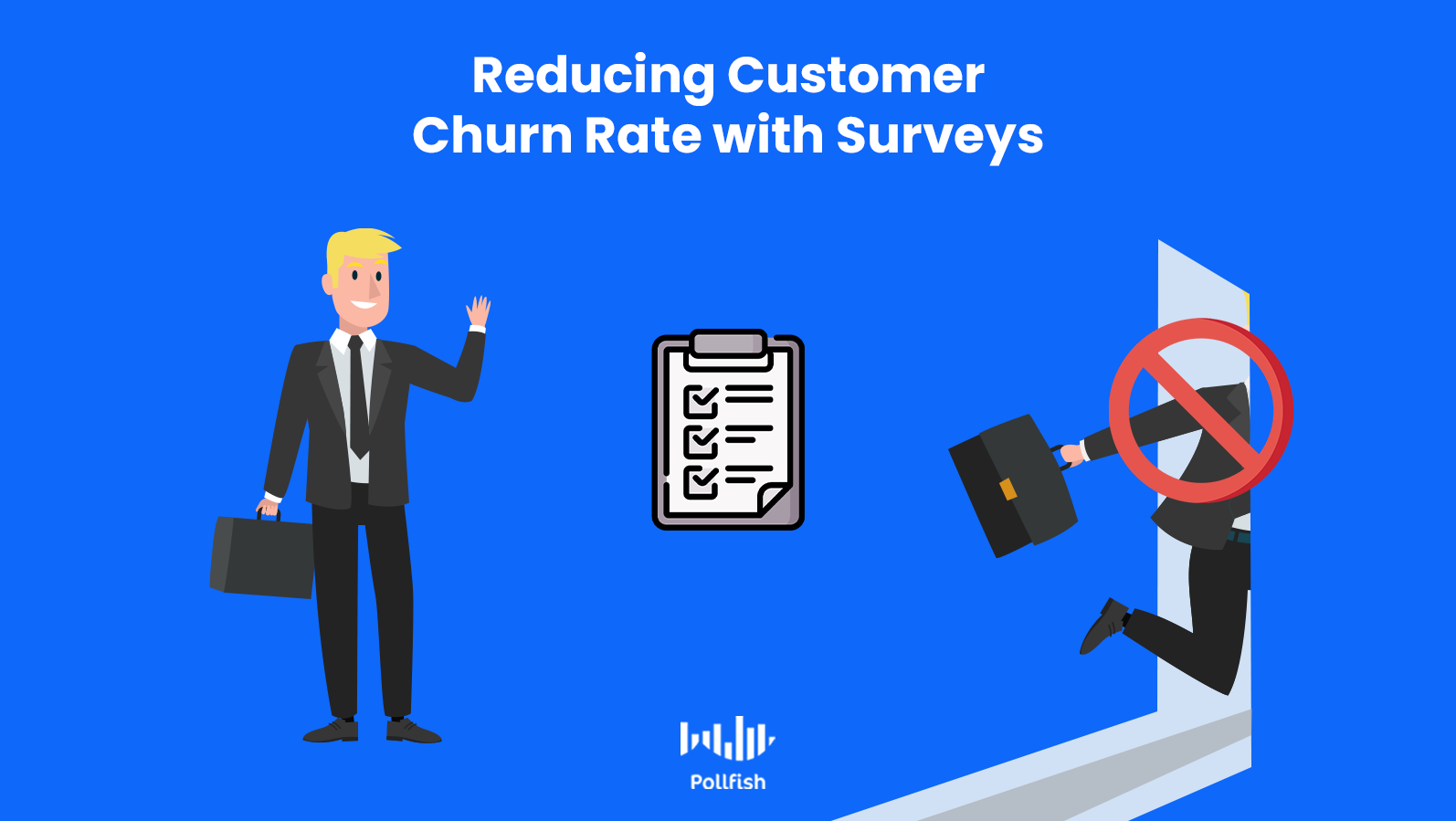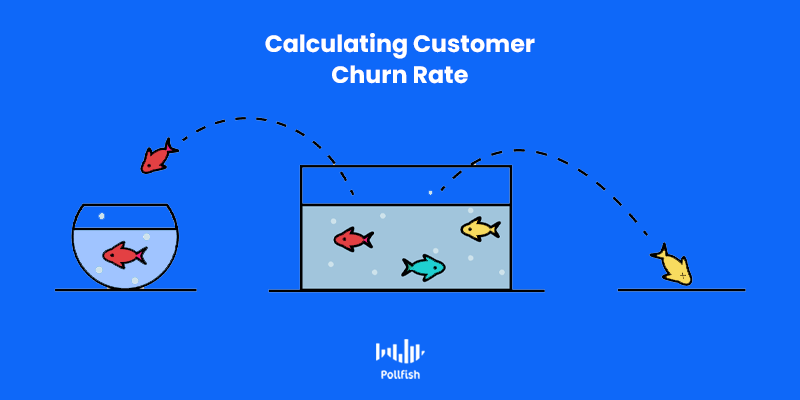How Surveys Help Reduce Customer Churn Rate

The customer churn rate can be a disappointing metric that businesses must contend with — that is, it measures a negative behavior, but when the rate is low, it signifies a positive business attribute.
This is because churn rate quantifies an aspect of financial health by way of a customer behavior; a low churn rate is indicative of favorable customer relations. Companies should strive for a low churn rate as it helps pave the way for a strong financial standing.
On the contrary, a high customer churn rate is bad news; it points to poor consumer loyalty, which all brands should avoid like the plague. Implementing market research, particularly surveys can help reduce churn.
This article explains what the customer churn rate is and how surveys are a proven antidote.
Defining the Customer Churn Rate
This is a financial metric that measures customer churn, which is a behavior defined by customers who stopped using a business’s products or services within a certain time frame.
Also called customer attrition, this metric is especially relevant for businesses who offer subscriptions or contract-based services. In this case, the churn rate specifically refers to the number of subscribers who either cancel their subscription or don’t renew it.
Customer churn rate is expressed as a percentage, in which the percentage refers to churned customers within a given time period.
“Churn” also alludes to loss on a larger scale; this means it can describe losses beyond customers alone. Here are a few examples of matters that churn rate determines:
- The number of customers (the most common measurement)
- The value of lost recurring business
- The percentage of the loss of recurring value
How to Calculate the Customer Churn Rate
Calculating churn rate is fairly simple; all you need is to consider two variables: the number of customers you lost within a time period and the number of customers you started off with previously.
Divide the number of customers you lost, say, in the last quarter, as is the common variable, by the customers you started with in the last quarter. Move the decimal point twice to the right to get the percentage. This percent represents the churn rate.
Example:
Customers you lost last quarter: 50
Customers you started with at the beginning of last quarter: 900
50/900= 0.05555555
Churn rate = 5.55%
This standard calculation also represents the simplest kind, as there are 4 ways to calculate churn rate. You ought to consider which calculation is most needed for the unique situation of your business.
It’s important to note that the simple method of calculating churn does not take newly acquired customers into consideration. For example, say you gained 40 new customers during the last quarter — these are not part of the formula, therefore do not count towards your quarterly churn rate.
It’s also critical to remember that the time period used above is just an example; you can quantify customer churn on a monthly or yearly basis if you so choose.
Why Churn Rate is Significant to Consider

You should be regularly checking your churn rate as it helps you gauge your customer loyalty. Loyal customers are unlikely to churn, so the ones that do are significantly less loyal.
By understanding the disloyal customers, you can craft better experiences, messaging and even product innovations to ensure less churn and therefore greater customer retention. In today’s competitive digital landscape, customer retention is more important than customer retention.
Not only is acquisition more expensive, as it costs 5 times more to acquire a new customer than to keep an existing one, but it also yields less profitable results. Customer retention, on the other hand, increases profits up to 95%, after a mere 5% increase in retention, as one study found. Therefore, it is key to a successful business.
Additionally, retention is critical, as existing customers don’t require as much persuasive efforts to stay with a business (they’re already doing so). They are also willing to spend more — up to 31% more, as well as being more inclined to try new products.
The lower your churn rate is, the greater your customer retention is for a particular time. As such, it is in the best interest of any business to keep churn rates low, so they must be carefully observed.
As far as customer retention is concerned, churn rate is also useful to study in comparison with Customer Lifetime Value (CLV), which measures a customer’s entire worth to a business during their lifetime relationship with one.
All in all, the churn rate helps you keep track of your lost customers. In order to keep this rate to a minimum, you must at the very least calculate it.
Customer Care: the Most Potent Way to Minimize Churn
Your product or service may be useful and necessary to your target market, but if you are disconnected from your customers, many of them are bound to churn. The strongest method to avoid churn or reduce it significantly is to provide the best care for your customer.
Caring for your customers involves a number of different actions, as it is not bound solely by friendly customer relations, as its name may suggest. Here are several ways to care for your customer to minimize churn rates:
- Offer multiple methods of communication, to ensure your customers that they are being listened to and heard. This will also allow you to understand what they seek and what they loathe.
- Create incentives; these help your company stand out among competitors and grant your customers more value.
- Formulate a loyalty program; this incites multiple purchases, fostering retention and relationship-building with your customers.
- Implement a strong VoC (voice of the customer) program for customers to be able to express their grievances and desires.
- Practice social listening, the process of overseeing social media networks for mentions of your company and competitors. This will give you a firsthand glimpse into how your customers feel about you in relation to other businesses in your niche.
- Personalize the customer experience, whether online or in-store, personalization shows customers that they’re not just another number making a purchase, but they are individuals you are being thoughtfully catered to.
- Reach out to customers yourself. Don’t wait for them to come to, as most often won’t unless they have a question or concern. Up your marketing ante via emails, social media and calls (especially if you provided free samples for the last method). This also shows customers that they are being heard and more personally served.
Survey Research: Providing a Breeding Ground for Better Customer Relations
Surveys help you achieve all of the techniques aforementioned in the prior section. This is because in order to coax your customers into loyalty and out of churning, you need to be able to understand them.
While plenty of software programs make promises of improving customer satisfaction and thereby relationships, surveys are the only alternative to get specific answers to both your own questions and those of your customers.
Surveys have the power to capture more than merely your customers’ needs. These vehicles allow you to gain direct insight into your customers’ minds on virtually anything: opinions on current affairs, aversions, desires, small irritation factors, shopping preferences, etc.
The better you understand your customers, the better you will serve them, whether it is through your marketing, branding, or product upgrade endeavors.
With mail-in surveys becoming obsolete, an online survey platform is the most optimal method for conducting your survey research.
Surveys help stamp out churn rate as they can be hyper-focused on one aspect of the customer experience. For example, you can create a survey to collect feedback on a recent order, an interaction with a salesperson or a chat representative, or you can gather opinions on current product updates, product glitches, ads and virtually anything else you can think of to avoid customer churn.
The latter is especially useful if the survey platform you use allows you to insert visual elements (images, GIFs, etc) to your questionnaires.
Surveys may appear to provide little depth as most have to be kept short to avoid survey attrition. However, you can design surveys with open-ended questions for a qualitative approach to your surveys. These allow customers to provide invaluable insights on why they churned or are thinking about doing so.
Prioritizing the Correct Actions to Reduce Churn Rate
Once you’ve gathered and analyzed data from your survey research, you’ll be able to understand what causes your unique customer churn rate. This will equip you with the knowledge to move forward with meaningful changes.
You should prioritize on the strongest influences to your churn rate and create a plan of action to reduce them. Survey research can point to problems you’ve never thought were present.
For example, perhaps your product or offering is perfectly fine and even desirable among your customer base. Instead, your customers churn due to poor customer support. This should prompt your business to adopt more training within this particular department.
Or, perhaps your product has no malfunctions; rather your customers want it to do something beyond its capabilities. It is possible that your competitors are already on to this and have adapted their product to this customer desire. Thus, it is easy to see why your customers churned. What’s most important is that with this insight in tow, you can inform your product team and prioritize on innovating.
This will lessen your churn rate in turn. When your churn rate is in decline, it translates to added revenue. Surveys can detect frustration with specificity, allowing you to avoid issues that contribute to customer churn.
Frequently asked questions
What is customer churn rate?
Customer churn rate is the percentage of customers who stopped using a company’s products or services during a certain period of time.
How is customer churn rate calculated?
In order to calculate customer churn rate, a company must first identify two figures for a certain time period: the number of customers who started off with the company and the number of customers who left. To calculate the customer churn rate for a certain period of time, divide the number of customers who left by the total number of customers during this time period.
Why is it important to track customer churn rate?
By understanding how your customer churn rate changes over time, a company can understand the factors that influence customers to stay or leave. The company can also work on creating a better customer experience to improve its churn rate.
What are some of the ways to minimize customer churn?
Customers are more likely to stay with a business if they feel a connection with the company, are easily able to contact the company, have an incentive to stay (i.e., via a loyalty program) and/or are satisfied with the customer experience in general.
How can survey research improve customer churn rate?
Surveys can provide direct and unique insights into the mindset of your customers so that you can enhance the customer experience, improve customer loyalty and reduce customer churn.
Pollfish Marketing Team
Ready to Try Pollfish?
Create your survey with AI, target high-quality respondents starting at $0.95 per complete, and start getting results in just minutes in real-time. From running a simple product concept survey to managing a constant stream of trackers for dozens of clients in dozens of countries, we’ve got you.

